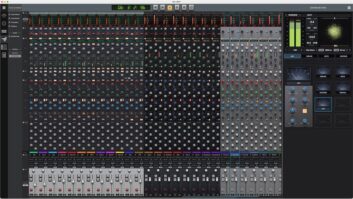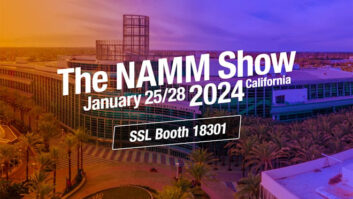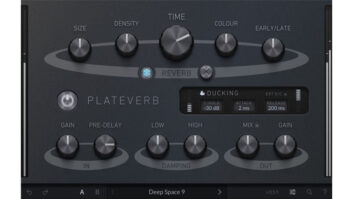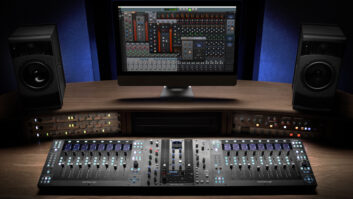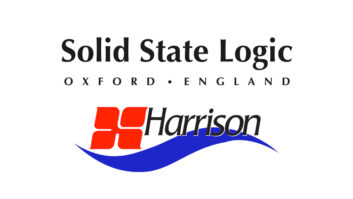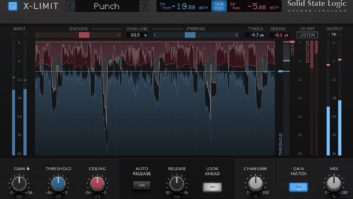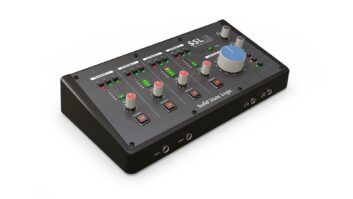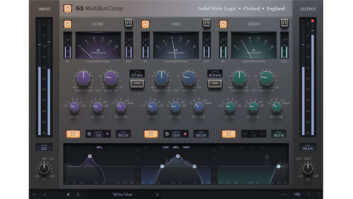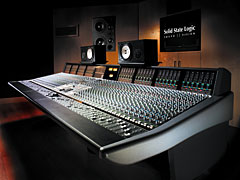

Traditionally associated with high-end consoles, Solid State Logic (www.solid-state-logic.com; AES Booth #610) began offering more affordable products about two years ago with the highly successful AWS900 console/controllers, followed by its XLogic outboard gear and Duende DSP engine. Now, with its new Duality line, SSL is addressing the market for analog consoles priced in the middle ground.
“The ‘Duality’ name comes from the many choices this console offers in terms of EQ, dynamics and topology,” says SSL’s director of commercial applications, Chris Jenkins. “Whether in terms of the console’s control or signal processing aspects, users have a choice of flavors.”
Offered in 48, 72 and 96-fader versions with integral DAW control, Duality may simply seem like an expanded AWS900, but this new mixer takes the console/controller concept to the next level. “The layout is similar to the AWS, but each channel strip features a full, 6-band, switchable SSL E/G equalizer,” Jenkins explains. “It has dynamics on every channel. The compressor follows the 9000 version, but in keeping with its Duality name, offers either an over-easy true RMS sidechain for transparent compression or a peak-sensing, hard-knee sidechain and linear release curve for a more exaggerated effect. It’s like having two completely different compressor sections in each channel strip. The gate/expander has a variable release with a fixed hold, which can be switched to a variable hold with a fixed release. You get the best of both worlds without cluttering the front panel with too many knobs.”
According to Jenkins, one of Duality’s major innovations is the Split-Channel Path, which enables the channel processing to be placed in the input or monitor path of your DAW. “We’re not really limited by track count in terms of the recording medium anymore, and when tracking, most people put every signal on its own track,” says Jenkins. “We came up with the concept of inserting the workstation into the channel strip. Users can choose whether the feed to the workstation — essentially the channel output — is either pre- or post-processing. And we have the split mode, which inserts the workstation’s return into the channel strip, so you can monitor off the workstation either with the processed signal going to, or on the return of, the workstation.”
On the DAW control side, Duality is similar to the AWS900, but offers full 32-fader control of Pro Tools and up to 96 faders of control for programs such as Steinberg Nuendo and Apple Logic that support the Mackie Control protocol. A digitally controlled gain element in each channel can switch the motorized faders to control any workstation while retaining the analog signal path. Channel rotary encoders provide direct control of DAW pans, sends, input and output routing.
Duality’s multiple 12-inch TFT displays show high-res metering, status, routing and more. “It can display an EyeconiX picture of what’s being recorded — either the person playing on the track or a picture of the instrument,” says Jenkins. “This is common on applications as simple as GarageBand, but has not been used on consoles yet. We also incorporated some of the graphics from our C100 and C300 digital mixers. You can look at the meter bridge and see exactly how your channels are configured, what processing is active, what the processing order is, where the workstation send points are and where the workstation signals are returned to.”
The console doesn’t have a keyboard for naming and instead uses a Web browser interface. “Logging in to the console’s IP address from a Web browser, you can upload icons and do labeling from the same PC as your workstation or another one,” Jenkins adds. “Then you can easily archive automation data or recall setups on the same media as the workstation data.”
Duality is equally at home doing stereo or surround. “This is the first analog 5.1 console that offers a fully variable, center focus control,” he continues. “This center-channel divergence control is continuously variable from hard center to phantom center and everything in between, so users can fine-tune exactly how the center image is generated. There’s a dedicated LFE send, so you have six buses for the main mix buses. There are also 24 track buses, so you could create five discrete 5.1 stems from the board.”
As far as sound goes, Duality provides the clarity of SSL’s SuperAnalogue™ straight-wire sonic performance, but with a choice of multiple sonic signatures, such as Variable Harmonic Drive™ (VHD). Incorporated in each channel strip, VHD was developed by SSL’s chief analog designer, Dave Mate, who created a circuit that has a tube-type overload characteristic. “You can vary the harmonic content from odd to very musical, even harmonics,” says Jenkins. “Also, a post-preamp gain trim lets users cascade gain sections to drastically alter the incoming signal, almost like a guitar amp. You can add valve warmth or you can make it sound extremely gritty, if that’s what you want.”
Jenkins notes that one challenge was keeping Duality’s physical size under control in spite of all the additional features. “We’ve managed to keep the center section fairly compact — 12 faders wide — and the console’s front-to-back depth is small enough that I can reach the back of a module without getting out of my seat. It’s a nice form factor that looks impressive without being a battleship.”
Duality pricing begins at less than $200,000 for a 48-frame version, making it a viable alternative to an older E , G or J Series console. Other than the number of channels (48, 72 or 96), options are few, but include 12-degree wings for the extra channels and a choice of patchbays. Duality is now shipping. The first board went to a Japanese studio last month and other pre-launch orders are in production.

WATCH:
SSL Duality Video
